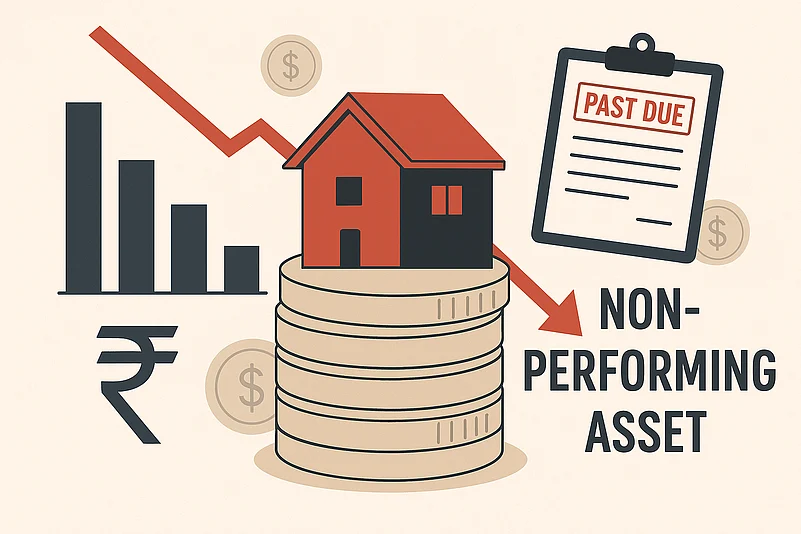Of late, the Indian banking industry has witnessed a steeper growth in non-performing assets (NPAs) related to credit cards. Credit card NPAs have risen more than 500 per cent from Rs 1,108 crore in December 2020 to Rs 6,742 crore in December 2024, according to figures from the Reserve Bank of India (RBI). Credit card NPAs represent 2.3 per cent of credit card loans outstanding, which was Rs 2.92 lakh crore as of December 2024.
Typically, when a borrower delays one or two payments, it may not seem like a big problem initially, but to the bank, the delayed payments more often than not marks the start of a prolonged and often multifaceted series of steps. The loan could eventually turn into an NPA—a term which is more than a metaphorical red mark on a balance sheet.
NPAs not only hurt a bank’s profitability, but also affect the flow of credit in the economy. From the beginning of default till the recovery or write-off, the life cycle of an NPA shows how financial institutions react to risk, defend their balance sheets, and attempt to rebuild confidence in the lending process.
1] Origination of Default
The NPA cycle starts as soon as the borrower defaults on his payment. In India, it turns into an NPA if 90 days and more of interest and/or principal falls due. It includes both personal loans, home finance as well as credit cards. The reasons behind the defaults could vary from a financial crisis and business economic adversities to the national or regional economies overall.
2] Internal Assessment by Banks
When the bank suspects a default, it carries out an internal study to examine the financial position of the borrower. It involves checking the previous repayment history of the borrower, current financial position, and collateral value, if any. The intention is to confirm the extent of default and investigate potential curative measures, including restructuring the agreement of the loan or providing relief to the borrower for a short period.
3] Identification as NPA
When default exceeds 90 days, the loan is formally recognised as an NPA. Identification requires provisioning by banks to consider potential losses, which affects profitability and capital adequacy. The Reserve Bank of India (RBI) prescribes certain guidelines for provisioning based on the age of the asset as a non-performer.
4] Recovery Initiatives
After identification of NPA, banks use different channels for recovery of due amounts:
Restructuring the Loan: This includes altering the terms of the loan, such as extending the term of repayment or lowering the rate of interest, to benefit the borrower.
Settlement Agreements: This includes settling an all-monetary payment in one lump sum by the borrower, typically less than due, in complete and final settlement.
Manmeet Kaur, partner at Karanjawala & Co., a legal firm, says, “In the event of repeated defaults and the account being classified as an NPA, the relevant banks or financial institutions may initiate legal action against the borrowers under the Securitisation and Reconstruction of Financial Assets and Enforcement of Security Interest (SARFAESI) Act before the Debt Recovery Tribunal (DRT). In such cases, the lender is legally entitled to take possession of the mortgaged property to recover the loan amount.”
5] Asset Reconstruction Companies (ARCs)' Role
Where the recovery efforts fail internally, banks can dispose of the NPA to Asset Reconstruction Companies. ARCs buy such defaulting assets at a discounted price and try to recover the dues through their process-oriented mechanisms. Banks can clear their balance sheets through this sale and concentrate on core banking activities.
6] Write-Offs and Provisioning
Once all chances of recovery are ruled out, the banks may decide to write off the NPA from their books of account, deeming it worthless and erasing it from their books. This does not release the borrower; there is still recovery available. The banks write down their provisions simultaneously for the loss, as reflected in their books of account.
In terms of credit NPA, excessive charging of interest on pending balance, financial strains, and increased consumption expenditure have been cited as some of the reasons behind this increase in NPAs.
The rise in NPA highlights the need for careful lending and good risk management in loan, typically, unsecured loans, such as credit cards.
The NPA cycle is a multi-step process with several stages, beginning from early default to potential write-off or recovery. Accurate handling of NPAs is of paramount importance for the banking system’s health as well as that for the overall economy. The recent spike in credit card NPAs goes to reinforce how critical good credit judgment, close monitoring, and timely intervention can ensure that the risk coming from NPA remains within acceptable limits.










